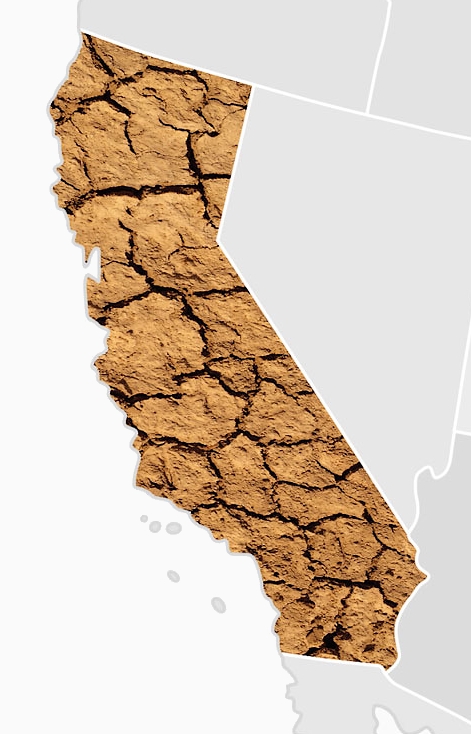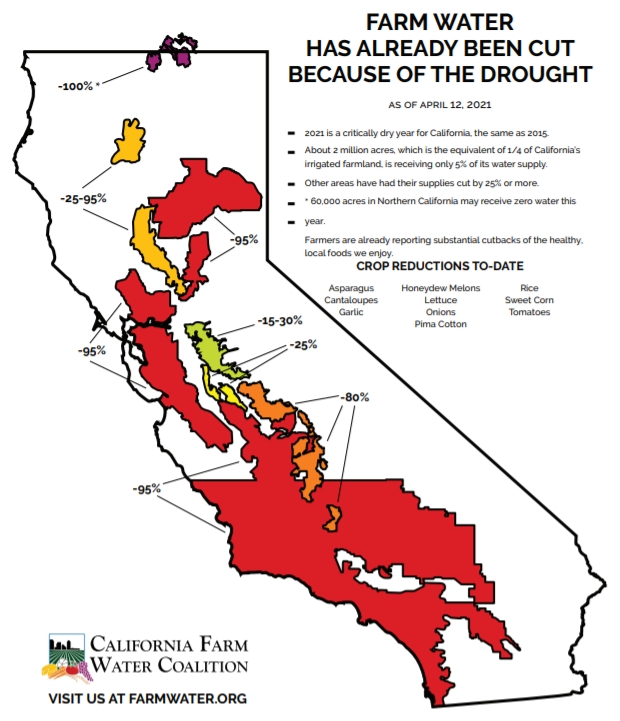"The real question is: Is there real water available to buy?"
Late March; the Department of Water Resources (DWR) announced an allocation reduction for the State Water Project (SWP). Initially, the allocation announced in December was for 10 percent of requested supplies for the 2021 water year. DWR has now lowered the allocation to five percent. The new allocation amounts to 210,266 acre-feet (almost 260 million m3) of water that is to be distributed among 29 SWP contractors. This means that the 29 SWP contractors who serve more than 27 million California residents, and 750,000 acres of farmland will have to share 210,266 acre-feet of water. DWR has indicated that the reduction is in response to the ongoing drought conditions California is experiencing.
The State Water Resources Control Board recently issued notices to approximately 40,000 farmers, municipal officials, and others, warning of potential water supply shortages.
California farmers try to plan for a critically dry year
With all signs pointing to a critically dry year in California, farmers are trying to add flexibility to help them make it through the season. Given the latest allocation restrictions, all sectors of agricultural production are impacted and are looking for solutions - not to save water but - to adapt their activity to the very low volumes available.
 Tulare County farmer and dairy operator Tom Barcellos said he expects to receive "almost nothing" this year when it comes to water supply.
Tulare County farmer and dairy operator Tom Barcellos said he expects to receive "almost nothing" this year when it comes to water supply.
"This year, it doesn't look like we're going to get much out of the Tule River; there's just basically no water coming," Barcellos said. "We've got more acres than we've got water, so naturally we're going to have to fallow some and concentrate on what we can irrigate."
Barcellos farms in the Lower Tule River Irrigation District and buys water through a Class 1 contract with the Central Valley Project (CVP) Friant Division. As such, he would receive a 20% supply. Barcellos grows much of his own dairy feed and said he plans to fallow acreage that would have been planted with corn silage. Instead, he will purchase baled mixes of hay that he would have grown himself if he had more water. Like other farmers facing limited water supplies, Barcellos said he is concerned about high prices for purchasing supplemental water.
"The real question is: Is there real water available to buy?" he said.
CVP contractors in the western San Joaquin Valley, who had received only a 5% initial allocation, saw the allocation suspended late last month.
Fresno County-based Woolf Farming buys water from the Westlands Water District, which is supplied through the CVP. Daniel Hartwig, the farm's resource manager, said the delayed 5% allocation "means a lot of uncertainty and people don't know how to plan, and it means a lot of growers are having to go out into the market to try and buy water, but there's very little available."
Woolf Farming began planting tomato transplants in early April. Hartwig said the farm had to order the plants back in December, to be sure they'd be available.
"Even if we get that 5% (allocation), that's like 2 inches of water per acre, so unfortunately, we're going to have to lean a little bit on our groundwater this year," he said.
Cotton will be the farm's "flex crop," Hartwig said, meaning the farm will adjust cotton plantings based on the amount of water available.
 See also additional information below
See also additional information below
According to a recent release from California Farm Water Coalition, “about 2 million acres of California’s irrigated farmland, or one out of every four acres, has already had its water supply cut by 95 percent. Another million acres has lost 80 percent of its water supply this year with much of the remaining farmland experiencing cuts of 25 percent or more.
Critical reservoirs, including Shasta, Oroville, Folsom, Millerton, and San Luis combined have 1.1 million acre-feet less water in storage today than they had at the end of March in 2015, California’s last critically dry year. Levels in these reservoirs are currently at 56 percent of average, compared to 72 percent of average at this time in 2015”.
Nick Rocca, whose family farms raisin grapes and almonds in Fresno County, said the Fresno Irrigation District has allocated 40% supplies. The district receives water from Pine Flat Reservoir and the Kings River, and can supplement with purchased water from the CVP Friant division.
"We're not going to get our first water delivery until June or July, which means I'm going to get two to three water deliveries, maybe, and I'm going to have to pump more," Rocca said. "There will be ground in the district that doesn't get farmed this year, and farmers right now are trying to decide which ground that is."
Farmers throughout water-short areas also face restrictions on groundwater, as local agencies prepare to implement the Sustainable Groundwater Management Act, or SGMA. Barcellos said his district is located in the Tule Basin, which is critically overdrafted.
"We know, as farmers, that we're in a critical year," he said.
Secretary Vilsack Declares Drought Conditions in California
On March 5, 2021, U.S. Secretary of Agriculture Tom Vilsack has designated 50 counties in California as being primary natural disaster areas because of recent drought conditions. In a letter to Governor Gavin Newsom (see also additional information below), Secretary Vilsack indicated that the classification of a natural disaster was based on readings from the U.S. Drought Monitor. According to the findings, 50 counties in California suffered severe drought for at least 8 weeks, or experienced extreme or exceptional drought at any time.
Most of the processing tomato producing counties are listed among the 50 counties most affected by the ongoing drought.
Additional areas of California and surrounding states have also been named as contiguous disaster counties. In total, all areas of California are now considered natural disaster areas due to drought. The designation from Secretary Vilsack means that farmers and ranchers are considered eligible for assistance programs through the Farm Service Agency. Producers will need to apply for assistance within eight months of the disaster declaration.
Along with the suspension of certain CVP deliveries, the State Water Project reduced its allocation to 5%, down from an initial 10%, and the State Water Resources Control Board sent early-warning notices to some 40,000 water rights holders, urging them to plan for potential shortages by reducing water use and adopting conservation measures.
Amid the drought hitting California and other Western states, a coalition of more than 200 agricultural and water organizations said it would urge the federal government to further bolster investment in the nation's aging water facilities.
In response to an infrastructure program unveiled by President Joe Biden in early April, the coalition—which includes the California Farm Bureau—said it looks forward to working with the administration and Congress on the larger need for Western water infrastructure, such as aboveground and underground water storage and conveyance facilities, along with federal financial mechanisms for such water projects.
"To ensure that food can continue to be safely and affordably produced in the West, and that rural communities continue to have access to the water critical to their economies, it is important that water supply investment be included as a necessary component of a national infrastructure package," California Farm Bureau President Jamie Johansson said. "We will continue to work with congressional leaders to build on the administration proposal with enhanced funding for water infrastructure."
The coalition said the drought makes it "even more critical to recognize the need for rural water infrastructure investments to capture and store water for use when it is needed most."
Source: California Farm Bureau Federation, agalert.com, CFWC
Further details in attached documents:


 Tulare County farmer and dairy operator Tom Barcellos said he expects to receive "almost nothing" this year when it comes to water supply.
Tulare County farmer and dairy operator Tom Barcellos said he expects to receive "almost nothing" this year when it comes to water supply.



























